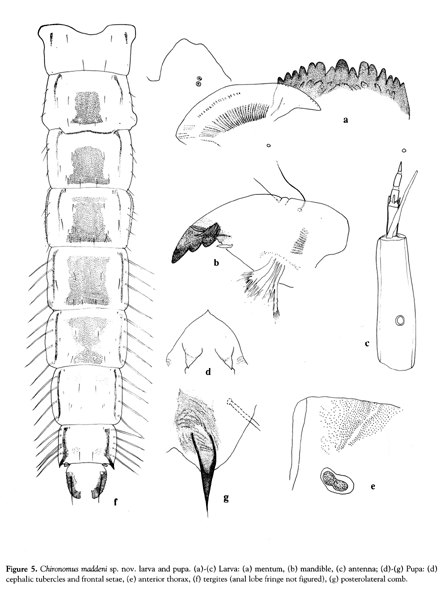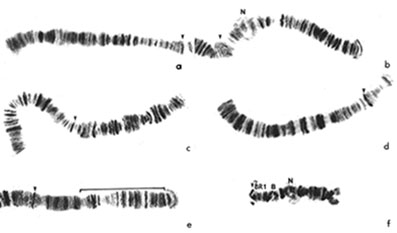C. maddeni Martin & Cranston, 1995Fourth instar larva: Medium size bathophilus-type larva, length about 15-18 mm (female), 13-14 mm (male). Posterior ventral tubules usually slightly longer, anterior about 0.66-1.25 mm; posterior about 0.68-1.30 mm. Head capsule with slight darkening towards the posterior margin of gula, and very slight darkening of frontoclypeus.
Similar to larva of other members of the C. oppositus group.
Mentum (Fig. a, below) of type II, c2 teeth separated from relatively narrow c1 (type III).
Ventromentum (Fig. a, below) with about 29-35 striae. Premandible with the usual two teeth, inner tooth broader.
Basal segment of antenna (Fig. c, below) about 3.5 times as long as wide; RO about a third to 2/5 up from base; AR about 2.28-2.32; A2/A1 about 0.23; relative segment lengths (micron) 131 : 31 : 9 : 12 : 6.
Mandible (Fig. b, below) with third inner tooth pale and unseparated (type IA), about 12-13 grooves on outer surface near base. 
Illustrations of the immature stages of C. maddeni
From Martin & Cranston (1995)Cytology: 4 polytene chromosomes with the pseudothummi arm combination AE, BF, CD, G.
Arm G with a median nucleolus and one obvious Balbiani ring between it and the presumed centromere. Large nucleolus developed near the centromere of arm F. No polymorphism known.
madA1: 1a-e, 11 - 10, 2c - 1f, 3e - 2d, 8 - 9, 3f-i, 14c - 13, 7 - 4, 12a-c, 14d - 19
madB1: Bulb with distal dark bands about one third from distal end. as oppositus B2
madC1: Appears unlike other known sequences
madD1: Appears unlike other known sequences
madE1: 1 - 3e, 10b - 3f, 10c - 13 as oppositus E1
madF1: 1 - 2a, 10 - 2b, 11 - 23 as oppositusF1
madG1: Median nucleolus, BR between centromere and nucleolus; BR1(Pct-1) near centromere 
a. Arm B; b, Arm F; c. Chromosome DC; d. Arm F; e. Arm A; f. Arm G.
Arrowhead - centromere; B (& BR1) - Balbiani rings; N- NucleolusPupa: The pupal tergum and some other pupal characters are shown in Figs. e-g (above).
Pale brown, with tracheal bases, abdominal apophyses, posterolateral spur and bases of anal lobe taeniae all darker brown. Thorax with dense brown rugulosity to midpoint.
Length about 7.9 mm, inner margin of wing case about 1.58 mm. Cephalic tubercles about 122-157 µm long, with a seta about 28-32 µm in length.
Abdomen with very restricted shagreen, present only along apophyses on TV and TVI. Pedes spurii B quite strong on II, pedes spurii A on IV, much weaker on V, absent on VI. Tergal spinule pattern as in Fig. f (above). Hook row on segment II with about 60-77 hooks, taking about 50-80% of the width of the segment. Conjunctives all bare. Paratergite IV with narrow spines, remainder bare. Setation typical for genus. Posterolateral spur simple, narrow, tapering to a point, with 1Ð2 spines; anal lobe with about 75Ð92 at least double ranked taeniae on each side. See also C. maddeni adult[ Return to Index | Go to References ] |

